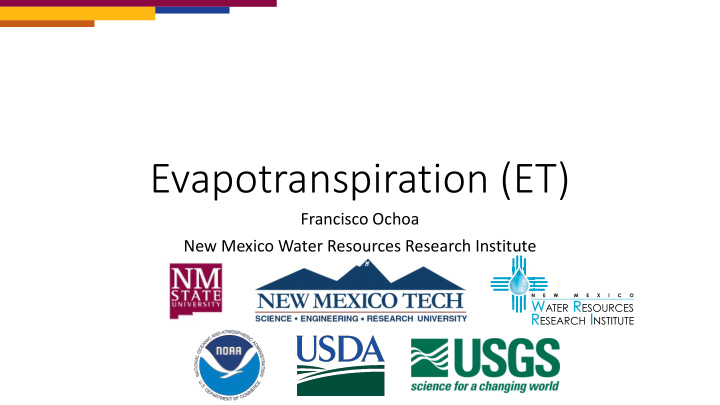



Evapotranspiration (ET) Francisco Ochoa New Mexico Water Resources Research Institute
Mapping the invisible – Remote Sensing Approach • ET modeling efforts are based on remote sensing, the observation of the Earth from space borne satellites • Collaborated with experts from USGS, USDA, NOAA and various universities in modeling, ET, remote sensing, and hydrology • ET research being conducted by Landsat 8 in orbit (Photo courtesy of NASA) this project is at the cutting edge of current science
Evapotranspiration in New Mexico • Available ET remote sensing based models • REEM – Regional Evapotranspiration Estimate Model (NMSU) • METRIC – Mapping Evapotranspiration at high Resolution with Internalized Calibration (University of Idaho & NM Tech) • ETRM – Evapotranspiration and Recharge Model (NM Tech) • SSEBop – Simplified Surface Energy Balance Model (USGS) • ALEXI – Atmospheric Land Exchange Inverse Model (USDA/NOAA) • Joint ET model research approach from NM Tech, NMSU, and USGS • Irrigated lands: SSEBop – Simplified Surface Energy Balance Model (USGS) • Non-irrigated lands: ETRM – Evapotranspiration and Recharge Model (NM Tech)
Ensemble Evapotranspiration Tool • Provides mean ET estimates for irrigated and non-irrigated areas at different spatial scales • USGS HUC8 Watersheds • New Mexico Water Planning Regions • New Mexico Counties Current user interface of the ensemble ET tool (under development)
Evapotranspiration Modeling Outcomes • Better resolution and improved quality of statewide ET • ET data are being incorporated into NMDSWB model for better understating of our hydrological cycle • Developing ET ensemble method and GIS tools for use by stakeholders
Recommend
More recommend